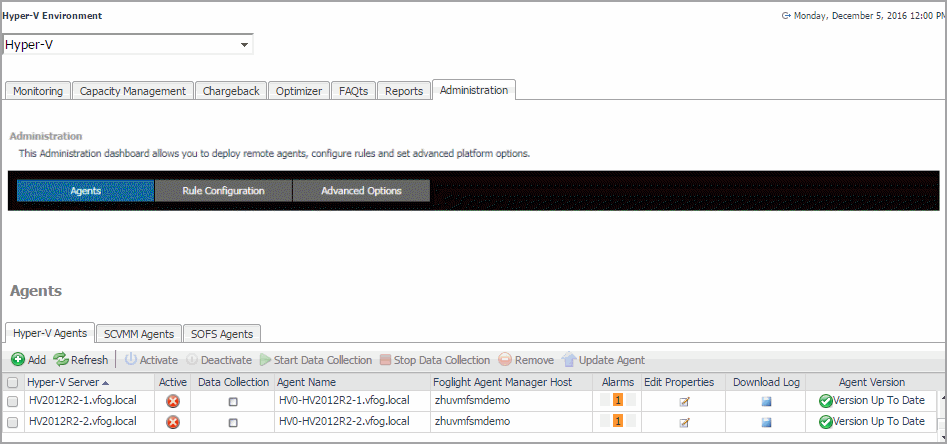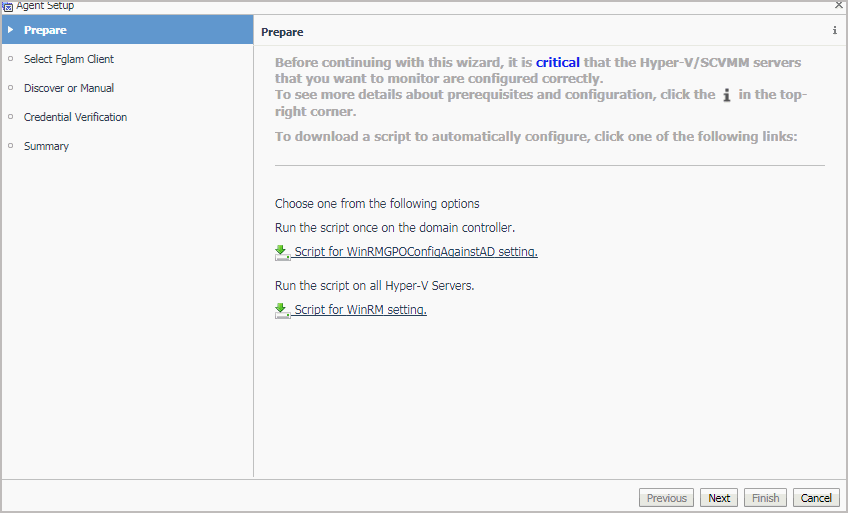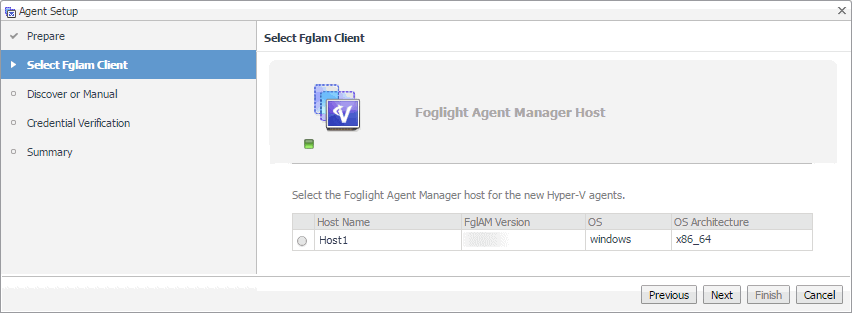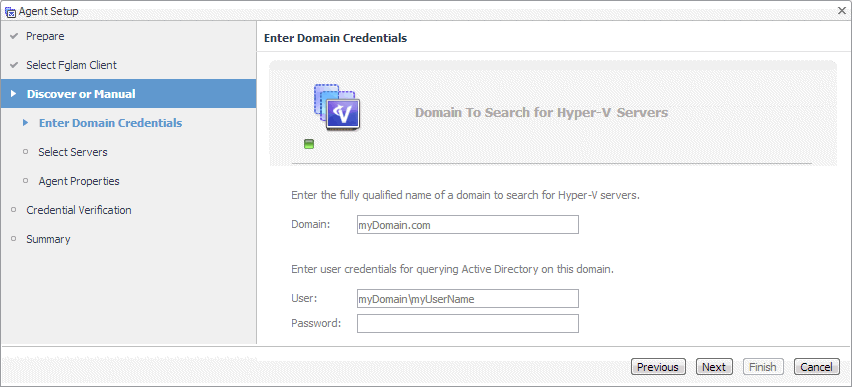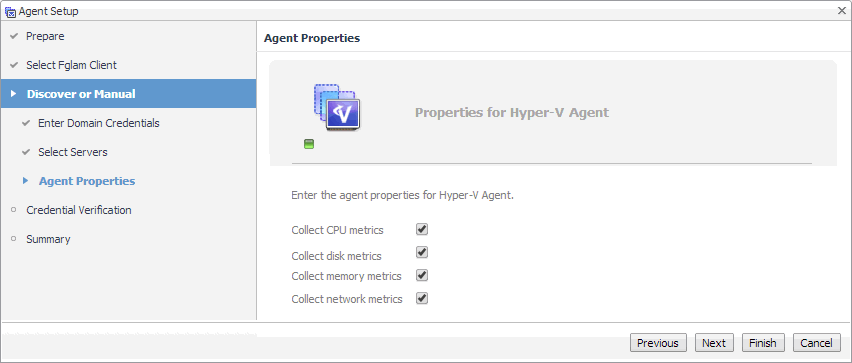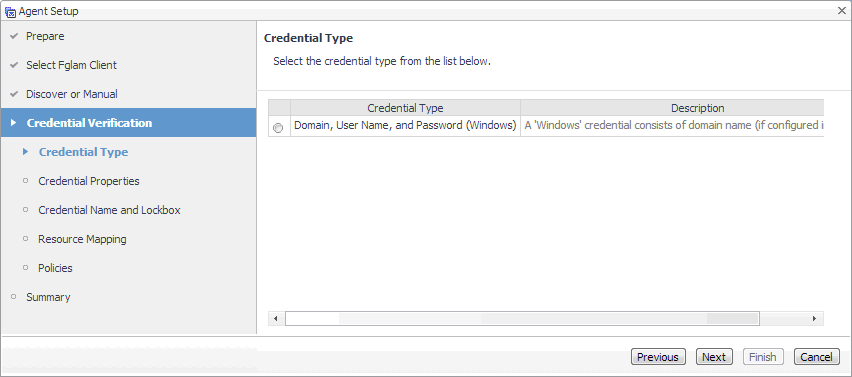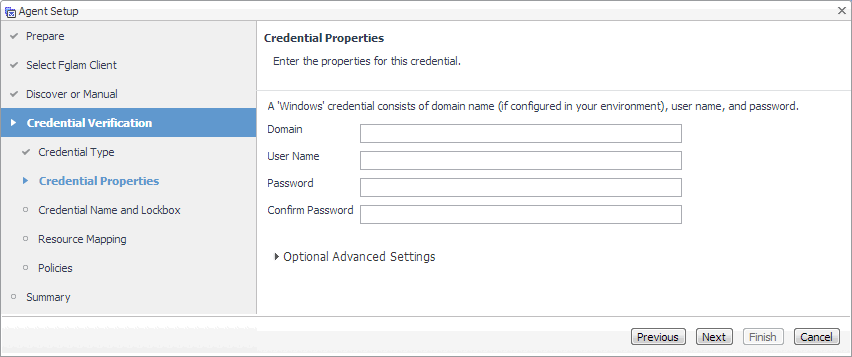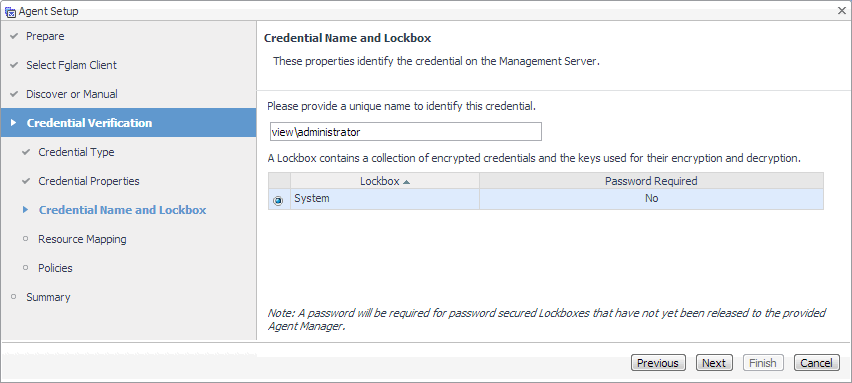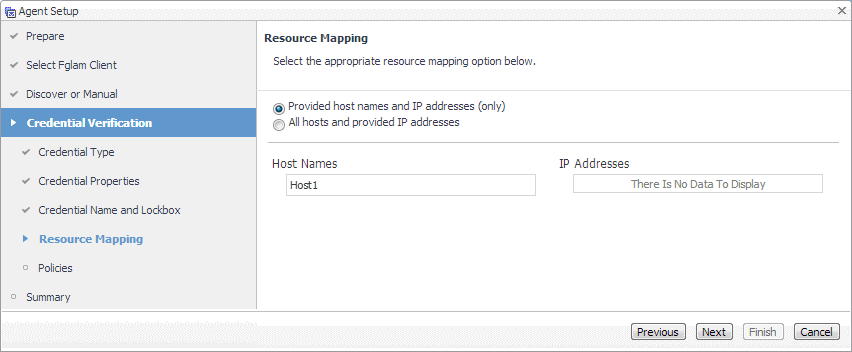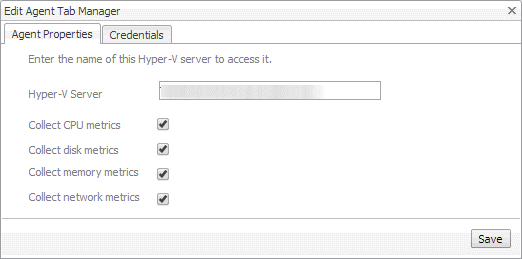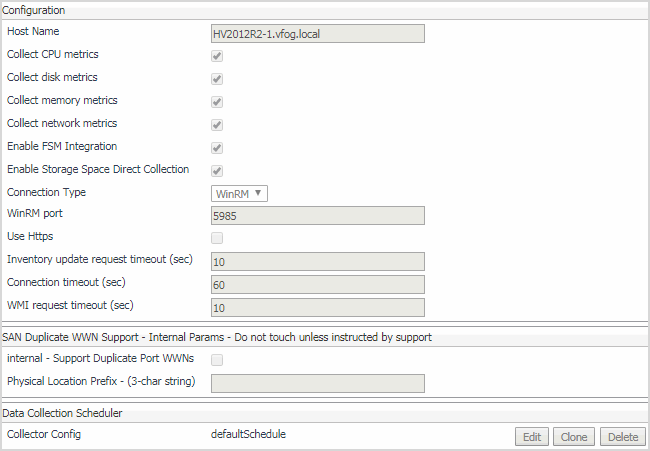Configuring monitoring agents
Foglight® for Hyper-V uses the Hyper-V, SCVMM, and SOFS agents to collect information about your virtual environment:
|
• |
Hyper-V Agents collect information from monitored Hyper-V servers. A Hyper-V server is a physical component required to begin building a virtual infrastructure. Hyper-V servers provide hypervisor-based architecture for controlling and managing resources for the virtual machines that run on it. |
|
• |
SCVMM Agents collect information from Virtual Machine Managers (VMM). A VMM allows you to manage host, networking, and storage resources when creating and deploying virtual machines to virtual clouds. |
|
• |
SOFS Agents collect information from monitored SOFS servers. A SOFS server is a Windows Server cluster with some form of shared storage. SOFS servers provide highly available file-based storage for applications and general use. |
When Hyper-V, SCVMM, and SOFS agent packages are successfully deployed, you can create agent instances, activate them, and start their data collection. To perform these steps in a single operation for one or more monitored hosts, use the Agents area on the Administration tab.
|
2 |
|
3 |
On the Hyper-V Environment dashboard that appears in the display area, click the Administration tab. |
|
4 |
On the Administration tab, under Agents, open the Hyper-V Agents, the SCVMM Agents tab, or the SOFS Agents tab, as required. |
|
5 |
|
• |
To configure these settings manually, see the Agent Manager Guide. |
|
8 |
Hyper-V Agents only. On the Discover or Manual page that appears, you can indicate if you want to manually specify the Hyper-V Server that you want to monitor, or to choose between the servers running in a given domain. |
|
a |
Discovering Hyper-V Servers only. On the Enter Domain Credentials page that appears, specify the information needed to search for the running Hyper-V Servers. |
|
• |
Domain: Type the fully qualified name of a domain to search for the Hyper-V Server. For example, myDomain.com. |
|
• |
User: Type the user name to be used by the agent to be used to query Active Directory on the selected domain using the syntax Domain\UserName. For example, myDomain\jsmith. |
|
• |
Password: Type the password associated with the above user name. |
|
d |
|
b |
Manually specifying a Hyper-V Server only. On the Manual Agent Properties page that appears, specify the information needed to search for the running Hyper-V servers. |
|
c |
On the Credential Verification page that appears, review the existing set of credentials. If the wizard determines that the selected Agent Manager has any credentials configured for the host on which the Hyper-V Server is running, they appear listed on this page. |
|
9 |
SCVMM Agents only. On the Input Agent Properties page that appears, type the name of the SCVMM server, and click Next. |
|
10 |
On the Credentials Verification page that appears, select one of the following options: |
|
• |
Do not configure a credential: Select this option if you want to configure the credential for this resource at a later time. Click Next and continue with Step 13. |
|
• |
Add host(s) to a new credential: Select this option if you want to add the host to a new credential. This option is suitable if none of the existing credentials have the connection details needed to access the new host. Click Next and continue with Step 11. |
|
• |
Add host(s) to an existing credential: Select this option if you want to add the host to an existing credential. This option is suitable if an existing credential has the security data needed to access the new host, but you need to edit its resource mappings to include this host. Click Next and continue with Step 12. |
|
a |
On the Credential Type page that appears, select the credential type from the available options. |
|
b |
Click Next. |
|
c |
|
d |
On the Credential Name and Lockbox page, provide a name to uniquely identify the credential, and select a lockbox in which you want to keep the credential. A lockbox can be used to group credentials for access and/or security. In smaller Foglight installations, using the default System lockbox should be sufficient. |
|
e |
On the Resource Mapping page, indicate which hosts you want to associate with this credential. Click Next. |
|
f |
Optional—On the Policies page, define one or more policies for this credential. A policy defines the number of times a credential can be used, the number of allowed authentication failures, the time range during which the credential is valid, or the length of time the credential data can be cached on the client. For example, you can specify the number of times the credential can be used, or the time period during which it can be used. For complete information about the available credential policies, see the Administration and Configuration Help. |
|
a |
On the Credential page that appears, select an existing credential to contain this host. |
|
b |
Click Next. |
|
c |
On the Resource Mapping page, indicate which hosts you want to associate with this credential. You can either select the host that you are about to start monitoring, all monitored hosts, or hosts whose name contains a specific text string. |
|
13 |
On the Summary page that appears, review the information provided about the host and the monitoring agent. |
|
14 |
Click Finish. |
|
a |
Select an agent and click Edit Properties. |
|
c |
Open the Credentials tab, and review the available credentials. |
|
• |
New credentials. Click New Credential and use the Create Credential Wizard that appears to provide the required information. For more details, see Step 11. |
|
• |
Existing credentials. Click Add to Existing Credential and use the Create Credential Wizard that appears to provide the required information. For more details, see Step 12. |
|
18 |
Click Refresh. |
Configuring agent properties
Default versions of these properties are installed with Foglight® for Hyper-V. However, you can edit the default shareable and agent properties, configure agent properties that apply only to a specific agent instance, and create edited clones of shareable properties that are used by a subset of agents of a certain type.
There are two ways to access the Hyper-V, SCVMM, and SOFS Agent properties:
|
• |
On the Hyper-V Environment dashboard, on the Administration tab, select an agent instance and click Edit Properties (see Configuring monitoring agents ). |
|
NOTE: This method only allows you to edit the Configuration properties, but not the Data Collection Scheduler properties. |
|
• |
On the Agent Status dashboard, select an agent instance and click Edit Properties. This method provides access to the full set of Hyper-V Agent properties, and is described in this topic. |
For more information about working with agent properties, see the Administration and Configuration Help.
|
e |
|
f |
Setting the Hyper-V Agent Configuration properties
To monitor a desired Hyper-V® server, ensure the Hyper-V Agent’s Configuration properties are set up as required.
|
1 |
Locate the Hyper-V Agent’s Configuration properties. |
|
2 |
Set the Configuration properties as follows: |
|
• |
Host Name: Type the fully qualified host name of the machine on which the monitored Hyper-V Server is running. |
|
• |
Collect CPU metrics: Select this option if you want to collect CPU metrics from the monitored Hyper-V environment. |
|
• |
Collect disk metrics: Select this option if you want to collect disk metrics from the monitored Hyper-V environment. |
|
• |
Collect memory metrics: Select this option if you want to collect memory metrics from the monitored Hyper-V environment. |
|
• |
Collect network metrics: Select this option if you want to collect network metrics from the monitored Hyper-V environment. |
|
• |
Enable FSM Integration: Select this option if you want to enable the integration with Foglight for Storage Management. |
|
• |
Enable Storage Space Direct Collection. Select this option if you want to collect Storage Space Direct (S2D) metrics from the monitored Hyper-V environment. |
|
• |
Connection Type. Specify the connection type. Quest recommends using WinRM as the connection type, as DCOM will be removed in future release. |
|
• |
WinRM port. Type the port number of WinRM. |
|
• |
Use Https. Select this option if you want to use the HTTPS protocol. |
|
• |
Inventory update request timeout (sec): Type the number of seconds after an inventory collection times out. |
|
• |
Connection timeout (sec): Type the number of seconds after a connection times out. |
|
• |
WMI request timeout (sec): Type the number of seconds after a WMI request times out. |
Setting the SCVMM Agent Configuration properties
To monitor a desired System Center Virtual Machine Manager (SCVMM), ensure the SCVMM Agent’s Configuration properties are set up as required.
|
1 |
Locate the SCVMM Agent’s Configuration properties. |
|
2 |
In the Configuration area, in the SCVMM Host Name box, type the name of the machine on which the Virtual Machine Manager is running. |

